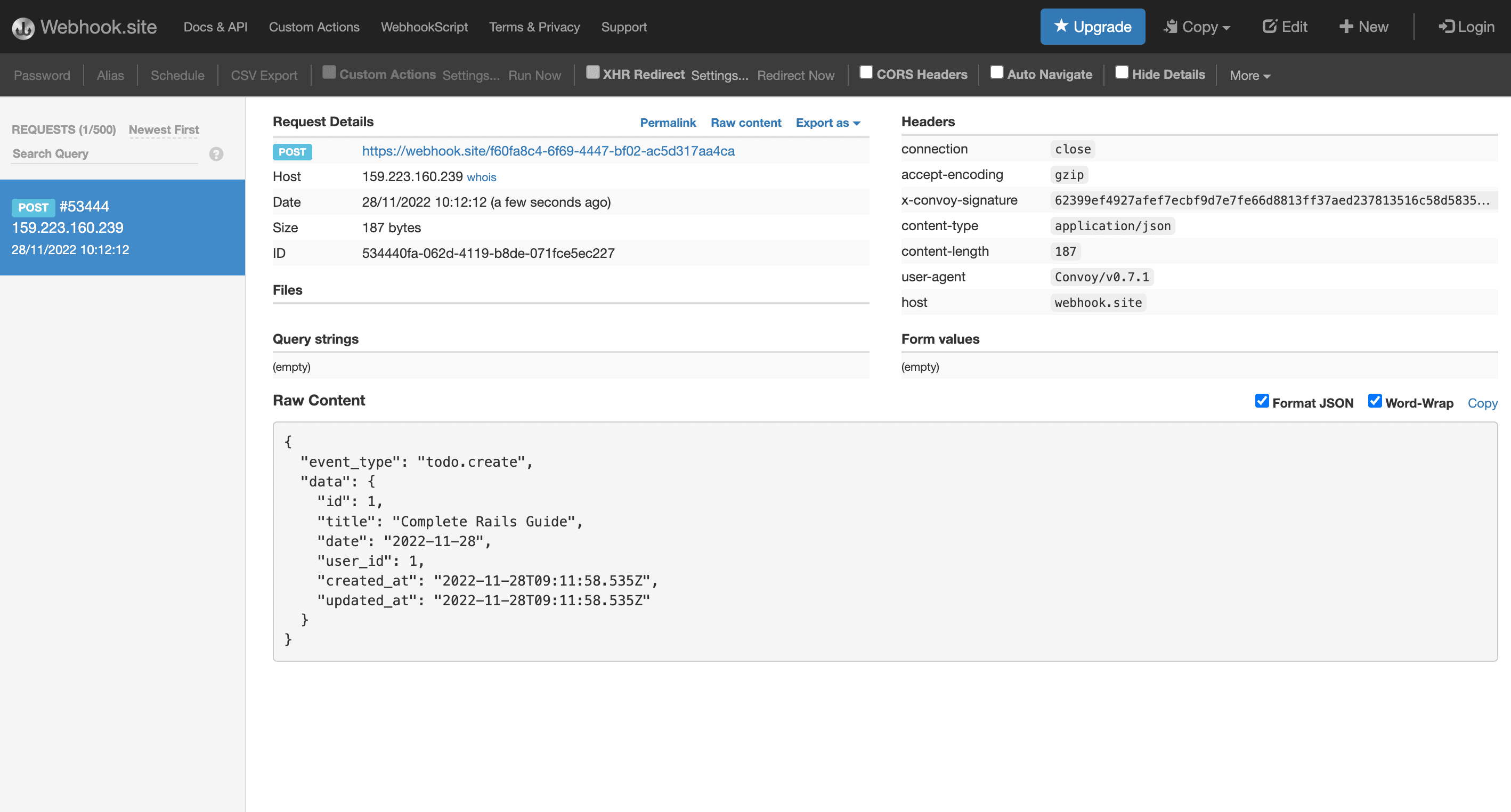Webhooks are messages ( or payload ) sent from an application after the execution of an operation. They are also used to communicate between a chain of services; for example, a payment provider emits webhook events to an e-commerce application’s endpoint after a payment operation. Convoy facilitates publishing webhook events from your application to your clients by serving as a reliable egress.
In this article, we will build a Todo API in Rails and use Convoy to publish webhook events for each operation on our Todo items; create, update & delete.
Prerequisites
To follow along you would need the following
- A Convoy Cloud account.
- An Outgoing Project ID & API Key.
For the sake of brevity, we created an additional resource to help with creating user endpoints, usually, users will supply this information to you via your dashboard. [2] We have also left out other aspects of the code not necessary for this guide.
API Spec
Our API looks like this:
- Endpoint
GET /endpoints GET /endpoints/:id POST /endpoint PUT /endpoint/:id DELETE /endpoint/:id - Todo
GET /todos GET /todos/:id POST /todos PUT /todos/:id DELETE /todos/:id
Every time we create, update and delete a todo item, we would generate the following events — todo.created, todo.updated, and todo.deleted respectively.
Let’s Build Our API
Project Setup
terminalrails new convoy-todo-api && cd convoy-todo-apiEndpoints API
Endpoints APIclass EndpointsController < ApplicationController before_action :set_endpoint, only: %i[show update destroy] def index endpoints = Endpoint.all render status: 200, json: endpoints end def show if @endpoint.nil? render status: 404, json: {} return end render status: 200, json: @endpoint end def create endpoint = Endpoint.new(endpoint_params) # Create on Convoy create_endpoint = Convoy::Endpoint.new( data: { name: "endpoint-#{rand(1000)}", description: "default endpoint", url: endpoint.url } ) res = create_endpoint.save # Save id as convoy_id endpoint.convoy_id = res.response['data']['uid'] endpoint.save if endpoint.nil? render status: 400, json: endpoint.errors return end render status: 200, json: endpoint end def update if @endpoint.nil? render status: 404, json: {} return end # Update on Convoy update_endpoint = Convoy::Endpoint.new( id: @endpoint.convoy_id, data: { name: "endpoint-#{endpoint.id}", description: "default endpoint", url: endpoint.url } ) update_endpoint.update endpoint = @endpoint.update(endpoint_params) render status: 200, json: endpoint end def destroy if @endpoint.nil? render status: 404, json: {} return end convoy_endpoint = Convoy::Endpoint.new(@endpoint.convoy_id) convoy_endpoint.delete endpoint = @endpoint.destroy render status: 200, json: endpoint end private def set_endpoint puts params[:id] @endpoint ||= Endpoint.find_by_id(params[:id]) end def endpoint_params params.require(:endpoint).permit(:url, :user_id) end endTodos API
Todos APIclass TodosController < ApplicationController before_action :set_todo, only: %i[show update destroy] def index todos = Todo.all render status: 200, json: todos end def show if @todo.nil? render status: 404, json: {} return end render status: 200, json: @todo end def create todo = Todo.create(todo_params) if todo.nil? render status: 400, json: todo.errors return end send_webhook_event("todo.created", todo) render status: 200, json: todo end def update if @todo.nil? render status: 404, json: {} return end todo = @todo.update(todo_params) todo = @todo.reload send_webhook_event("todo.updated", todo) render status: 200, json: todo end def delete if @todo.nil? render status: 404, json: {} return end todo = @todo.destroy send_webhook_event("todo.deleted", todo) render status: 200, json: todo end private def set_todo @todo ||= Todo.find_by_id(params[:id]) end def todo_params params.permit(:title, :date, :user_id) end def send_webhook_event(event_type, todo) endpoint = todo.user.endpoint event = Convoy::Event.new( params: { groupID: ENV['CONVOY_PROJECT_ID'], }, data: { endpoint_id: endpoint.convoy_id, event_type: event_type, data: { event_type: event_type, data: todo.as_json } } ) event.save end end
Publish Webhook Events
It’s time to publish your first webhook!
To begin, we start our rails app
terminal$ rails sSecond, we create an endpoint with the cURL command below:
terminal$ curl --request POST \ --url "localhost:3000/endpoints" \ -H "Content-Type: application/json" \ -d '{ "user_id": "1", "url": "https://webhook.site/f60fa8c4-6f69-4447-bf02-ac5d317aa4ca" }'Finally, we create a Todo item, that in turn generates the webhook item. Let's use the cURL command below:
terminalcurl --request POST \ --url "localhost:3000/todos' \ -H 'Content-Type: application/json' \ -d '{ "title": "Complete Rails Guide", "date": "2022-11-28", "user_id": "1" }'The API returns a successful response:
{ "id": 9, "title": "Complete Rails Guide", "date": "2022-11-28", "user_id": 1, "created_at": "2022-11-28T08:04:18.235Z", "updated_at": "2022-11-28T08:04:18.235Z" }
Let’s see our event deliveries dashboard.

Let’s also see our webhooks endpoint

Appendix
- In production environments, Endpoints should be scoped to each user/business/customer or whatever makes sense in your case because at the point of generating webhooks
- Users can supply their endpoints through multiple means — your dashboard, the portal link
- In this article, we publish webhooks in our controllers, in an ideal production environment, you should publish them from your workers.
Conclusion
Convoy provides the ability the send webhooks to one endpoint as well as multiple endpoints. In this article, you learned how to create send webhooks from a Rails API. We hope you enjoyed reading this, and that you get to try it out and give us some feedback on the slack community!
